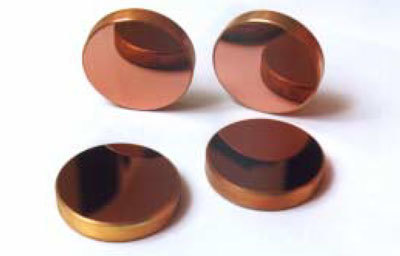Product
제품
PODUCT INFO
Optics
Cu ‘Supermax’ Mirrors

Copper ‘Supermax’ Mirrors
Introduction
Supermax-coated mirrors are the most highly reflective of all the Cu mirror types. They consist of
a copper substrate, diamond-machined to the required surface form, then vacuum-coated with a
reflectivity-enhancing dielectric stack.
The coating retains high reflectance properties for both ‘S’ and ‘P’ polarizations when used at 45
degrees incidence angle, with near zero phase shift.
All copper used in the manufacture of these mirrors is high-specification, oxygen-free (OFHC).
The manufacturing methods employed in fabrication of Supermax mirrors (economically) limits the
types of mirrors offered to those which may be made in reasonable volume.
Dimensions / tolerances
Supermax mirrors can be fabricated in sizes up to 100mm diameter, and in thicknesses to suit the
mirror diameter and type of cooling required.
The standard available types are limited to specific popular laser spares, although the available range
will increase with time.
Specifications/tolerances are:
Diameters : +0 / -0.15mm
Thicknesses : ± 0.15mm
Parallelism : ETV within 0.03mm
Surface form accuracy : <λ/20 (10.6μm) over 90% of dia.
Surface roughness : <50Å RMS
Phase retardation : <1° (at 45° incidence)
Reflectivity : >99.8% (see tables 11.42, 11.43)
LIDT : see below
The reflectivity stated in these specifications is the guaranteed value. Measured samples usually give slightly
higher R% values.
Standard sizes
Sizes in technical data section 11.0 do not apply.
Consult ULO Optics for list of standard types.
Custom-made products
Supermax mirrors can be custom-made. As a guideline, it will probably be economical to consider
custom-manufacture only for quantity requirements in excess of 20-off.
Laser Damage Thresholds
Pulsed LIDT:
The pulsed LIDT has not been measured.
Supermax mirrors are not recommended for use in pulsed CO2
lasers.
CW LIDT:
Measured values of CW LIDT for uncooled, unstressed Supermax
mirrors are, typically:
525 W/mm +/- 10% (section 11.0 explains LIDT units)
For the LIDT in terms of ‘kW/cm2’, see table 11.41.
As detailed in section 11.0, the ‘intensity-based’ LIDT is different
for each laser power.
 Reflectivity
Reflectivity
Table 11.42 gives calculated values of R% for a range of wavelengths at
normal incidence.
Table 11.43 gives actual values of reflectivity, measured* on typical
samples, for normal incidence and 45 degrees incidence, at a wavelength
of 10.6 μm.
NB: * Average of 3 samples, from 2 batches.

